Janice Matichuk: Quetico Ranger and Ambassador to the Wilderness
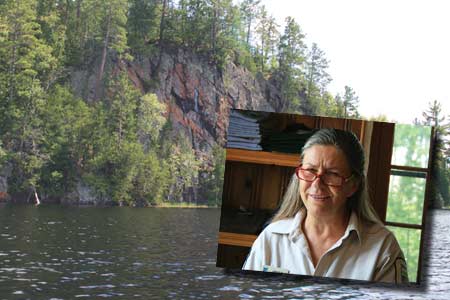
When Janice Matichuk accepted the position of Interior Park Ranger for Quetico Provincial Park in 1985, her daughter was five months old. The Cache Bay Ranger Station where she was posted lay 1,000 miles away from the log home she and her husband were building in eastern Ontario. Uprooting for the seasonal job would mean being a 16-kilometer motorboat ride and a six-hour drive from Atikokan, and living in near isolation with an infant. But the young couple gave it a go. They packed up the baby, the family dog, and 2,000 pounds of gear—including a diaper pail, a crib, a high chair and four months of canned goods and frozen foods—and moved into a small island cabin on Cache Bay. “We had no idea what we were getting into,” Janice remembers.
A plane delivered dairy, bakery and fresh vegetables twice a month. Janice called in her grocery list a week in advance, and once the plane delivered their food, she had to make it last two full weeks. All the while, she balanced raising an infant with issuing permits and teaching visitors how to respect the wilderness.
But something about the lifestyle clicked. In 1988, Janice had a second child, and each of her kids spent 16 summers on the island. And for 17 years Janice, her children and pets did the 1,000 mile trek to Atikokan in early May and then back home in mid September to get the kids in school. Even after she and her husband separated in 1997, Janice continued to work as a ranger. Last summer was her 28th year on the job. She goes there alone now since her children are grown, and Janice is the longest serving interior ranger in the history of the park. She’s also the only ranger to stay at one station for so long.
“The island is just heaven on earth for me,” she says. “I like the challenge of the isolation and the challenge of living with the elements of nature and having to live with it as opposed to battle it.” Her experience has given her a unique window into the value of wilderness and the changing face of Quetico visitors.
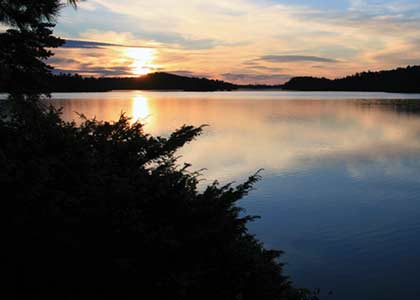
Sunset on Cache Bay.
The Job of a Ranger
Strictly speaking, Janice’s job is to make sure that campers understand the rules and regulations in the park, and that payment is in order. But she thinks of herself as more of an ambassador on the doorstep to the wilderness. She knows the Cache Bay area of Quetico intimately, and she takes it upon herself to teach its visitors a respect for the land and the consequences of making mistakes. She likes to chat with canoeists, even joke around to get a sense of their goals and tailor her speech to their needs.
“If they have a lot on their minds about fishing, I really get onto them about respect for fish,” Janice says. “Reminding them of the limits, the basics about cleaning up, respect for the campsite. For new comers, I go in-depth.”
She pays close attention to their skill levels, and if unsuspecting canoeists are headed for the Falls Chain she sets them straight. Water levels can change dramatically along the chain of waterfalls, making portage landings hard to find and exposing inexperienced paddlers to strong currents. Janice has been known to steer beginners to other, safer routes because above all, she wants people to understand the power of nature.
“One of the things I’ve wanted to say and do say to a few people is, ‘Strip yourself down. Naked, no shoes either. Get bear butt naked and walk 100 steps from your campsite just through the bush. You will know in nanoseconds who is boss,” she says.
The Life of a Ranger
That power of nature is one of the things that Janice likes best about the life of an interior ranger. She rises to the challenge of being in charge of her own safety, and what appears to be a tiny cabin to most people feels like a castle to Janice. “The cabin was built in 1957, but I have running water, a tub, a propane stove and freezer, fridge, lights and outhouse. I now have internet on the island, required for permits and fish licenses, but I was hard pressed to use it,” she says.
For Janice, using the internet felt shameful. She prided herself on not having electricity, or a phone or even a computer. She liked the way it forced her and her children to engage with each other and play board games—even though they called them B-O-R-E-D games, she could see the way that wilderness had seeped into their bones.
Thankfully when I felt like I was neglecting them by being so busy in my job, they were outside talking to campers and spouting off all kinds of stuff about the park. It was just a matter of fact to them that the loons would hatch in two weeks or there were moose on the island,” she says.
They developed an intimate knowledge of the natural world, and Janice got to watch them grow and change even as the forest around her did the same. These days, with more time to herself, Janice likes to walk the perimeter of the island and observe how the trees have grown. She’s been known to put her arms around a tree and marvel at how it has changed since her arrival on the island, to grow weepy at the beauty of the land.
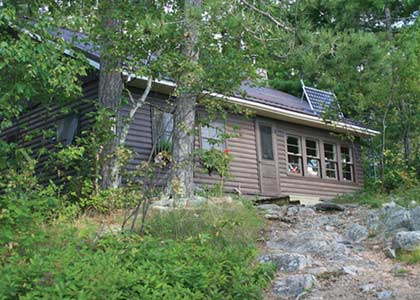
Ranger Cabin and check-in station located on Cache Bay, Sagagana Lake.
The Life of the Wilderness
It’s the beauty of Quetico Provincial Park that Janice wants people to know first hand. She has watched as the face of the average visitor has changed. When she began her job, most people entering Quetico were 40 to 60 years old. Now, they’re in their 70s.
“I shake my head at them. I can’t even get off my mattress in the morning without moaning and groaning, and they’re getting up off rocks in the morning. I just admire them,” she says.
She calls them lifers, and she urges them to bring their children and grandchildren the next time they come. She knows from a park survey that usage of the park has gone down, and most of its visitors are returning visitors. They come every summer, occasionally getting the itch to travel somewhere else but always finding their way back to Quetico. Janice worries that politicians and bureaucrats will look at the declining numbers and decide that the value of wilderness has diminished.
When she received a medal of valor for helping rescue five canoeists, she used her time at the podium to remind park officials of the park’s value, and the importance of having rangers on the ground.
“Nothing has changed on the land. It breathes and sighs with the water level,” she says. And in many ways, Janice does, too. She spends her winters volunteering and giving slideshows about raising kids in nontraditional environments, but it is the ranger station and the island on Cache Bay that she dreams about. “I’m so defined by Cache Bay I don’t know who Janice is without Cache Bay. I can’t put into words my love for that spot on the earth. When I come around Cache Point on Saganaga Lake and see my island, I just pass through a magic curtain.”
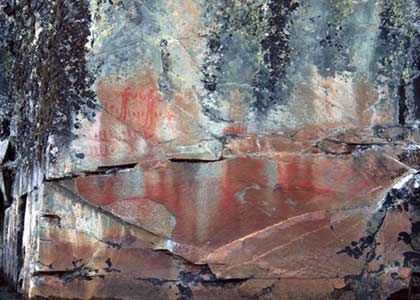
Cache Bay pictographs located in the westernmost terminus of Saganaga Lake.
This article was orginally published in the Summer 2013 issue of Wilderness News and has been republished with the permission of the Quetico Superior Foundation.



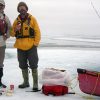






What a beautiful story, unfortunately Janice just recently passed away leaving a big hole in many peoples hearts. She was one very strong, independent woman with so many talents.